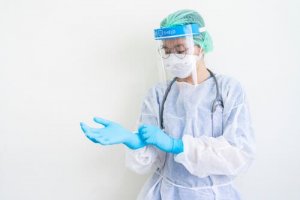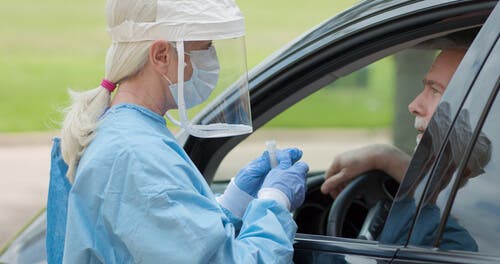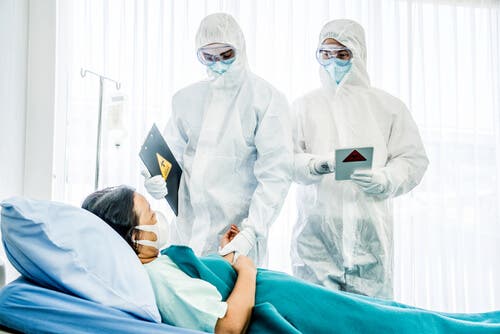What Is PPE?


Written and verified by the doctor Leonardo Biolatto
Currently, due to the coronavirus pandemic, fear has been taking control of many people. We’ve become accustomed to wearing masks or gloves. There are even a lot of people making PPE at home.
PPE stands for personal protective equipment. In reality, it’s any device that a person uses to protect themselves from some health or safety risk, like an infection. However, there are different types of PPE depending on the specific purpose. Additionally, they should fulfill a series of qualifications, and be correctly evaluated to be useful.
In this article, we’ll explain everything you need to know about this topic.
What is PPE?
PPE, as we mentioned, is any protective device for personal use. It’s usually manufactured to control risks. That’s why it’s coming into play in the world at this time due to the current risk of infection from the pandemic.
However, PPE should be used as part of a specific protection program. This point is important since officials need to evaluate the danger, manufacturing of the product, and even the training of the people who are going to use it.
This is because, for a device to really protect you, you have to properly care for and maintain it. This is a basic element of any risk control strategy. The majority of people who use PPE are health professionals.

Keep reading: Types of Masks to Protect Against Coronavirus
What do you use it for?
Since we’re talking about different devices, they have many different uses. First, you can use PPE for minor risks. In this category you can find, for example, helmets or safety glasses. They help protect you from small hits or crashes.
However, as we noted before, the most common uses of PPE are for health workers. Health professionals normally use them to protect themselves from infection. However, we should note that there are also specific devices to protect from radiation or contamination.
In the case of healthcare workers, the most common types of PPE are gloves and masks. They also normally include specific protective clothing and protective eyewear to completely cover the person.
You might be interested in: Should We All Wear Masks for Coronavirus?
PPE for coronavirus

Currently, the vast majority of PPE is being manufactured and used to protect health professionals against infection by coronavirus. This is a very important measure due to the high risk of transmission and infection from SARS-CoV-2.
Additionally, we should highlight that for PPE to be valid, it needs to satisfy several characteristics. This is why health systems are overloaded and lack materials since many centers weren’t prepared for a pandemic.
The first piece of equipment is a mask. This allows health workers to be near a person with symptoms while protecting their airways. Remember that you can be infected through particles that come from the nose and mouth.
Another part of the equipment is sanitary gloves, which should be disposable. Along with this, officials recommend they wear a hermetic uniform, which protects them from possible spray from patients. A normal coat doesn’t seem to be enough for this particular illness.
It’s also recommended for PPE to include eye protection. Glasses help prevent fluids from accessing the eyes. They can be safety glasses or complete facial screens.
Remember
We can’t forget that, for personal protective equipment to work, it has to satisfy certain conditions. The best thing is to inform yourself before using it since you need to know certain things to use it like how to put it on and take it off without risking contamination.
Therefore, it’s important to remember to only use PPE if you are trained, a health care worker, or have been told to do so by your doctor.
All cited sources were thoroughly reviewed by our team to ensure their quality, reliability, currency, and validity. The bibliography of this article was considered reliable and of academic or scientific accuracy.
- Calvo, Cristina, et al. “Recomendaciones sobre el manejo clínico de la infección por el «nuevo coronavirus» SARS-CoV2. Grupo de trabajo de la Asociación Española de Pediatría (AEP).” Anales de Pediatría. Elsevier Doyma, 2020.
- Feijoo, A. Montero, et al. “Recomendaciones prácticas para el manejo perioperatorio del paciente con sospecha o infección grave por coronavirus SARS-CoV-2.” Revista Española de Anestesiología y Reanimación (2020).
- Mendez-Rios, Jorge David. “Medidas Mínimas de Bioseguridad en instalaciones de salud durante la Pandemia del SARS-CoV-2 [Minimum Biosafety Measures in healthcare facilities during SARS-CoV-2 Pandemic].” Revista Médica de Panamá-ISSN 2412-642X 40.1 (2020).
This text is provided for informational purposes only and does not replace consultation with a professional. If in doubt, consult your specialist.








